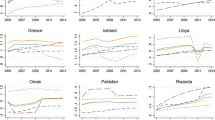Abstract
This paper provides an alternative way of measuring human development that takes explicitly into account the differences in the countries’ population structures. The interest of this proposal stems from two complementary elements. First, that there is an enormous diversity in the population structures of those countries analysed in the Human Development Reports, particularly the shares of old people in the population. Second, that demographic characteristics are relevant in the evaluation of development possibilities. We propose to change the way of measuring health, education and material wellbeing, in order to take into account those differences in the population structures. Regarding the health component, we substitute Life Expectancy at Birth by Life Potential (the average life expectancy of the current population); concerning education, we change the average between Mean Years of Schooling and Expected Years of Schooling by the Education Potential (a variable that mimics life potential in this context). As for the material well-being, we propose using the Gross National Income per adult, instead of per capita, while keeping logs in the evaluation. The resulting indicator, called Demographically Adjusted Human Development Index, is the geometric mean of the three new variables suitably normalised. We analyse empirically the effect induced by these changes in the evaluation of human development by comparing this way of measurement with the conventional Human Development Index (HDI) for 168 countries.







Similar content being viewed by others
Notes
There were also substantial changes in the design of some complementary measures, particularly regarding poverty.
We depart here from the HDI normalization strategy because the use of max and min goalposts induces some inconsistencies in the aggregation process, as discussed in Herrero et al. (2012).
This is so for a reason: avoiding the composition effect that derives from the use of mortality rates.
The groups are: [0,1], [2,4], [5,9], [10,14],..., [95,99], [100,\(\infty\)].
For the LEB we have used the data provided by United Nations for 2015.
Even though the LP and the LEB are not correlated, when we restrict to particular areas like Europe we observe that both variables are related (\(\rho =0.82\)).
For the MYS we have used the data from the United Nations in 2015. The rest of the variables are obtained from the dataset the UNESCO Institute for Statistics provided by the World Bank, and, for each country, they refer to the last available data in the database. As in the case of health, the data on the population are obtained from the US Census Bureau.
References
Abad-González, J., & Martínez, R. (2016). Endogenous categorization of the human development. Applied Economics Letters, 24, 243–246.
Acemoglu, D., & Restrepo, P. (2017). Secular stagnation? The effect of aging on economic growth in the age of automation. In NBER Working Papers, 23077.
Bilbao-Ubillos, J. (2013). Another approach to measuring human development: The composite Dynamic Human Development Index. Social Indicators Research, 111, 473–484.
Bloom, D. E., Canning, D., & Fink, G. (2010). Implications of population ageing for economic growth. Oxford Review of Economic Policy, 26, 583–612.
Fukuda-Parr, S., Lawson-Remer, T., & Randolph, S. (2009). An Index of economic and social rights fulfillment: Concept and methodology. Journal of Human Rights, 8, 195–221.
Harttgen, K., & Klasen, S. (2012). A household-based human development index. World Development, 40, 878–899.
Herrero, C., Martínez, R., & Villar, A. (2010). Multidimensional social evaluation: An application to the measurement of human development. Review of Income and Wealth, 56, 483–497.
Herrero, C., Martínez, R., & Villar, A. (2012). A newer human development index. Journal of Human Development and Capabilities, 13, 247–268.
Jahan, S. (2015). Human Development Report 2015. United Nations.
Kaufman, L., & Rousseeuw, P. (1990). Finding groups in data: An introduction to cluster analysis. London: Wiley.
Legendre, P., & Legendre, L. (2012). Numerical ecology. London: Elsevier.
Lind, N. (2010). Values reflected in the Human Development Index. Social Indicators Research, 66, 283–293.
Lutz, W., & KC, S. (2013). Demography and human development: Education and population projections. In Occasional Paper UNDP Human Development Report Office, 4.
Maestas, N., Mullen, K., & Powell, D. (2016). The effect of population aging on economic growth, the labor force and productivity. In NBER Working Papers, 22452.
Pinilla, R., & Goerlich, F. (2003). Renta per cápita y potencial de calidad de vida (QLP) en España (1981–1999). In Working Paper IVIE, 2.
Sen, A. (1987). Commodities and capabilities. Oxford: Oxford University Press.
Seth, S., & Villar, A. (2017a). Human development, inequality and poverty: Empirical findings. In C. D’Ambrosio (Ed.), Handbook of research on economic and social wellbeing. Cheltenham: Edward Elgar.
Seth, S., & Villar, A. (2017b). The measurement of human development and poverty. In C. D’Ambrosio (Ed.), Handbook of research on economic and social wellbeing. Cheltenham: Edward Elgar.
Shorrocks, A., Davies, J., & Lluberas, R. (2015). Global wealth report 2015. Zurich: Crédite Suisse.
Suri, T., Boozer, M. A., Ranis, G., & Stewart, F. (2011). Paths to success: The relationship between human development and economic growth. World Development, 39, 506–522.
United Nations. (2015). World Population Ageing 2015. Population Division: UN Department of Economic and Social Affairs.
Acknowledgements
The first author acknowledges financial support from Project ECO2015-65820-P (MINECO/FEDER,UE). The second author also wishes to acknowledge financial support from Project ECO2017-86245-P (MINECO/FEDER/UE), as well as Junta de Andalucía under Project SEJ426. The third author acknowledges financial support from Project ECO2015-65408-R (MINECO/FEDER/UE)
Author information
Authors and Affiliations
Corresponding author
Appendix
Appendix
See Tables 5, 6, 7, 8, 9 and 10.
Rights and permissions
About this article
Cite this article
Herrero, C., Martínez, R. & Villar, A. Population Structure and the Human Development Index. Soc Indic Res 141, 731–763 (2019). https://doi.org/10.1007/s11205-018-1852-0
Accepted:
Published:
Issue Date:
DOI: https://doi.org/10.1007/s11205-018-1852-0



